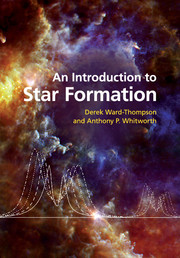Book contents
- Frontmatter
- Contents
- List of Illustrations
- Preface
- 1 Introduction
- 2 Probing star formation
- 3 The ISM – the beginnings of star formation
- 4 Molecular clouds – the sites of star formation
- 5 Fragmentation and collapse – the road to star formation
- 6 Young stars, protostars and accretion – building a typical star
- 7 The formation of high-mass stars, and their surroundings
- 8 By-products and consequences of star formation
- List of mathematical symbols
- List of figure credits
- Index
- References
3 - The ISM – the beginnings of star formation
Published online by Cambridge University Press: 05 June 2012
- Frontmatter
- Contents
- List of Illustrations
- Preface
- 1 Introduction
- 2 Probing star formation
- 3 The ISM – the beginnings of star formation
- 4 Molecular clouds – the sites of star formation
- 5 Fragmentation and collapse – the road to star formation
- 6 Young stars, protostars and accretion – building a typical star
- 7 The formation of high-mass stars, and their surroundings
- 8 By-products and consequences of star formation
- List of mathematical symbols
- List of figure credits
- Index
- References
Summary
Introduction
In this chapter we take a more detailed look at the interstellar medium (ISM). We consider first the most abundant element in the Universe, hydrogen. We discuss the atomic hydrogen transition which occurs at 21 cm. We look at the 21-cm line in both absorption and emission. We then go on to consider the molecular gas and, in particular, the most abundant gas-phase molecule after hydrogen, carbon monoxide (CO). We also look at the use of absorption lines in the study of the ISM. In this context we consider some features of spectral lines, such as their equivalent widths, and we describe the curve of growth of a spectral line. In the next chapter we will go on to study the denser parts of the ISM, known as molecular clouds.
The 21-cm line of atomic hydrogen
The most abundant element in the Universe is hydrogen. We here discuss the main signature of cool atomic hydrogen, 21-cm line radiation. Figure 3.1 shows 21-cm images of some nearby galaxies, illustrating how the 21-cm radiation traces the atomic gas in the interstellar medium of these galaxies.
- Type
- Chapter
- Information
- An Introduction to Star Formation , pp. 39 - 64Publisher: Cambridge University PressPrint publication year: 2011



